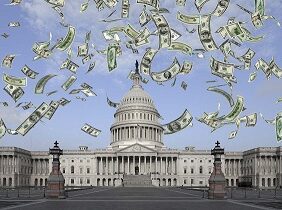The Inflation Reduction Act of 2022 includes provisions aimed at reducing the amount of methane released into the atmosphere from oil and gas development. Lost gas has a significant effect on the climate. As a greenhouse gas, methane has a global warming potential 28 to 34 times higher than carbon dioxide over a 100- year period. Every year, operators report losing tens of billions of cubic feet of natural gas from leases on federal lands. Beyond the climate impact, leaked, vented and flared natural gas is an obvious waste of valuable natural resources. A fee could be an efficient way to capture the climate costs of methane emissions that are currently ignored when oil and natural gas is sold.
Specifically, the bill creates fees for lost gas from oil and gas operations, including production, transmission, processing, storage, and gathering. Under current proposal, oil and gas operators would pay $900 per ton of methane emitted in 2024, increasing to $1,200 per ton in 2025, and $1,500 per ton in 2026, but with quite a few exceptions.
The proposed methane fee would only apply to facilities emitting more than 25,000 metric tons of carbon dioxide equivalent of greenhouse gasses annually. Currently, facilities that emit above this 25,000 metric ton threshold are required to report their annual greenhouse gas emissions to the Environmental Protection Agency (EPA). The methane fee proposed in the Inflation Reduction Act of 2022 uses this list of “petroleum & natural gas systems” facilities that report to the EPA as the fee base.
In 2020, the list comprised 2,377 facilities, which collectively reported 316 million metric tons (MMT) of carbon dioxide-equivalent (CO2e) emissions, including 81.8 MMT CO2e of methane—the largest component of natural gas. These emissions account for less than 40 percent of all U.S. oil and gas industry methane emissions [1]. There are many smaller facilities that may emit more methane as a percentage of overall production that would not be assessed the proposed fee.
Furthermore, these applicable facilities would only be charged if the methane they emit exceeds a certain portion of the total natural gas they send to sale.
| Waste Emissions Threshold for Methane Fees | |
| Oil and natural gas producers | 0.2 percent of natural gas sent to sale, or 10 metric tons of methane per million barrels of oil sent to sale |
| Nonproduction facilities (natural gas processors, liquified natural gas exporters, etc.) | 0.05 percent of natural gas sent to sale |
| Natural gas pipelines and transmission facilities | 0.11 percent of natural gas sent to sale |
So for example, if an onshore oil and gas producer sends 400,000 tons of natural gas from its wells (about 20 billion cubic feet) to a natural gas processing plant, it could emit 800 tons of methane without incurring any fee. If instead, the facility emits 2,000 tons of methane, the producer would have to pay the fee on 1,200 tons, which would amount to $1.08 million in 2024, $1.44 million in 2025 and $1.8 million in 2026.
The Inflation Reduction Act of 2022 also includes language anticipating new methane rules from the Environmental Protection Agency, and exempts companies that comply with new rules from the methane fees.
Apart from the methane fees, the Inflation Reduction Act of 2022 would also create the Methane Emissions Reduction Program to provide $850 million in incentives for the oil and gas industry to monitor and reduce their methane emissions, and another $700 million incentives specifically for owners and operators of conventional wells.
The new methane fee will create incentives for the oil and gas industry to reduce methane emissions by finally capturing at least a portion of the climate costs that methane emissions cause. Overall, although the fee proposed is quite moderate and comes with large exceptions, it will still be an improvement over the existing system. Under current rules, oil and gas companies are allowed to consume natural gas they remove from the well (so-called beneficial use) free of charge, and many drilling rigs and equipment leak significant amounts of methane into the environment. Drillers often burn off (flare) or simply release (vent) methane that is comingled with oil. All of this is allowed because the rules governing lost gas on federal lands were originally promulgated in 1979, long before modern drilling techniques like hydraulic fracturing or directional drilling were in use. TCS has analyzed self-reported data from oil and gas operators and will soon release our findings of lost revenue from these well-documented problems.
For more information about oil and gas leasing reforms included in the Inflation Reduction Act of 2022 and methane royalty, read our post here.
–
–
[1] Estimate comes from comparison between the 2020 reported emissions from the EPA’s Greenhouse Gas Reporting Program (GHGRP) and the EPA’s Inventory of U.S Greenhouse Gas Emissions and Sinks estimate for total methane emissions from Petroleum and Natural Gas Systems (Table 3-42 and Table 3-68).











Get Social